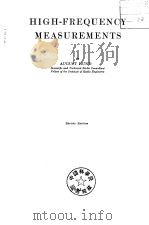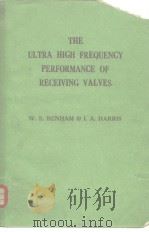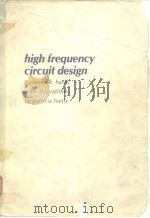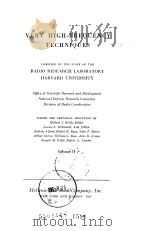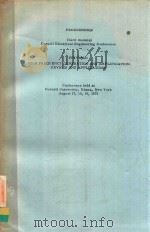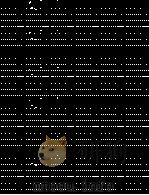《ULTRA HIGH FREQUENCY PROPAGATION》
| 作者 | HENRY R.REED CARL M.RUSSELL 编者 |
|---|---|
| 出版 | 未查询到或未知 |
| 参考页数 | 562 |
| 出版时间 | 没有确切时间的资料 目录预览 |
| ISBN号 | 无 — 求助条款 |
| PDF编号 | 811842428(仅供预览,未存储实际文件) |
| 求助格式 | 扫描PDF(若分多册发行,每次仅能受理1册) |
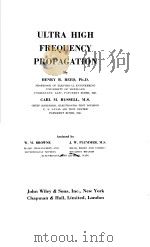
CHAPTER 1.AN INTRODUCTION TO UHF COMMUNICATIONS AND THE SYSTEM CONCEPT1
1.1.Meanings of VHF,UHF,and SHF1
1.2.Noise and the Desirability of Higher Frequencies in Communications1
1.3.Regions of Propagation3
1.4.Use of High-Power Transmitter to Give Rceeption in the Far Reaches of the Diffraction Region4
1.5.Ray vs.Wave Theories5
1.6.Variations in Predicted Values of Signal Strength6
1.7.Limitations at UHF and the"Systems Concept"12
CHAPTER 2.GENERAL ASPECTS OF PROPAGATION23
2.1.A Basic Procedure for the Development of a Radiation Pattern as Applied to a Flat Earth24
2.2.Equation of Constant Path-Length Difference Loci26
2.3.Example.A Particular Hyperbolic Equation27
2.4.Lobe Structure27
2.5.Relation between Path-Length Difference and Grazing Angle for a Particular Antenna Height28
2.6.Phase Lag28
2.7.Reflection Coefficient,R29
2.8.Directivity30
2.9.Gain32
2.10.Lobe Structure for Half-Wave Vertical Dipole.R=0.5,φ=180°32
2.11.Lobe Structure for Half-Wave Vertical Dipole.Use of Actual Re-flection Coefficient34
2.12.The ILS(Instrument Landing System)36
2.13.Equivalent Earth Radius37
Problems40
CHAPTER 3.METEOROLOGICAL THEORY42
3.1.The Standard Atmosphere42
3.2.Snell’s Law for Spherical Boundary Surfaces44
3.3.Curvature of Radio and Light Waves47
3.4.Modified Earth Radius.4/3 Earth Radius Diagram50
3.5.Earth as a Parabolic Arc52
3.6.The Non-standard Atmosphere53
Problems57
CHAPTER 4.ANTENNAS AND RADIATION PHENOMENA(GROUND REFLECTION BEHAVIOR)58
4.1.The Wave Equation and Its Solution for Free Space Propagation58
4.2.Poynting Vector63
4.3.Radiation from a Short Wire65
4.4.Radiation and Induction Fields69
4.5.Radiated Power from Short Wire69
4.6.The Half-Wave Dipole71
4.7.Radiation Resistance of the Half-Wave Dipole77
4.8.Field at a Distance from the Half-Wave Dipole77
4.9.Antenna Gain77
4.10.Reciprocity78
4.11.Effective Area of Antenna79
4.12.Example.Effect of Change in Effective Area81
4.13.Inverse Law of Radiation81
4.14.Reflection Coefficient82
4.15.Properties of the Medium83
4.16.Fundamental Considerations84
4.17.Horizontal Polarization88
4.18.Vertical Polarization90
4.19.Effect of Earth Curvature91
4.20.Evaluation of n2 in MKS Units91
4.21.Example.Calculation of Reflection Coefficient91
4.22.Surface Roughness98
4.23.Approximate Expressions for Reflection Coefficients99
4.24.Physical Path-Length Difference99
4.25.Equation for Constant Path-Length Difference100
4.26.Example.Calculation of Total Angle of Lag of Reflected Ray101
4.27.Divergence Factor102
4.28.Radio Horizon and Value of △h1 from Curved-Earth Geometrical Relationships108
4.29.Example.Calculation of Divergence Factor109
4.30.Gain.Earth Gain Factor110
4.31.Example.Calculation of the g(θ)Function110
4.32.4/3 Earth Radius Charts112
Problems115
CHAPTER 5.MULTIPATH PROPAGATION(GROUND-TO-AIR,AIR-TO-GROUND,AND GROUND-TO-GROUND PROPAGATION)117
5.1.Elementary Wave Theory117
5.2.Ray Theory121
5.3.Waves and Rays122
5.4.Validity of Ray Theory126
5.5.Multipath Propagation127
5.6.Two-Path Propagation128
5.7.Example.Calculation of a Typical Microvolt Contour136
5.8.Free Space Maximum Range of Dipole137
5.9.Radio Horizon Line139
5.10.Errors140
5.11.Tabulated Procedure for Calculation of Theoretical Lobe Structure141
5.12.Deviation from Theoretical Predictions148
5.13.A Short-Cut Procedure for Calculating Signal Strength and Its De-ficiencies149
5.14.Fallacy in Believing Maximum Height Provides Maximum Coverage Range154
5.15.Calculation of UHF Radio Field Strength in the Diffraction Region155
5.16.Calculation of the Surface Wave Field Strength for Short Ranges171
5.17.Conditions under Which the Surface Wave May Be Neglected172
5.18.Field Strength in the Turbulent Region175
5.19.Range-Microvolt Curve at Constant Elevation175
5.20.Deficiencies in Knowledge of the Art and the Use of Safety Factors178
Problems179
CHAPTER 6.COMPAIRISON OF VHF AND UHF PROPAGATION,DIPOLE-TO-DIPOLE(GROUND-TO-AIR AND AIR-TO-GROUND PROPAGATION)183
6.1.Vertical Lobe Structure185
6.2.Theoretical and Experimental Lobe Structures191
6.3.Field Strength vs.Range218
6.4.Circular Polarization220
6.5.Comparison of Horizontal with Vertical Polarization229
6.6.Over Land vs.Over Sea Water Propagation231
6.7.Theoretical vs.Experimental Reflection Coefficients.Surface Rough-ness233
6.8.Analysis of Frequency and Antenna Height238
6.9.Optimum Height for Antenna242
6.10.Example.Calculation of Solid Coverage Range246
6.11.Example.Optimum Antenna Height247
6.12.Example.Calculation of Solid Coverage Range250
6.13.Conditions Necessary to Obtain a Given Radiation Pattern at a Higher Frequency250
Problems252
CHAPTER 7.COMPLEX ANTENNAS(LINEAR ARRAYS)254
7.1.Arrays254
7.2.Broadside Array255
7.3.End-Fire Array256
7.4.Colinear Array256
7.5.Two-Element Array257
7.6.Three-Element Array259
7.7.n-Element Linear Array261
7.8.Free Space Field Strength Patterns of Colinear Arrays263
7.9.Colinear Array in Proximity of Earth267
7.10.Four-Element Colinear Array in Proximity of Earth270
7.11.Solid Coverage Range277
7.12.Electrically Tilted or"Dished-up"Antenna280
7.13.Null Positions for Linear Arrays of n Elements284
7.14.Nine-Element Linear Array285
7.15.Calculation of Radiation Pattern.Nine-Element Array292
7.16.Broadband Operation of a Given Array296
7.17.Diversity Antennas301
7.18.Two Half-Wave Vertical Dipoles in Height Diversity.Vertical Po-larization304
7.19.Two Four-Element Colinear Arrays in Height Diversity.Vertical Polarization308
Problems311
CHAPTER 8.COMPLEX ANTENNAS(CIRCULARLY POLARIZED ANTENNAS)313
8.1.Wave Polarization313
8.2.Circular Polarization.Free Space Conditiohs317
8.3.In Proximity of Earth319
8.4.Illustrative Example,Circular Polarization320
8.5.Crossed-Dipole Antenna323
8.6.Practical Design of a Circularly Polarized Antenna System324
8.7.System Improvement Obtained by Use of Circularly Polarized An-tennas329
Problems335
CHAPTER 9.SYSTEM COMPARISON,OPERATION,AND DESIGN OF UHF COMPLEX ANTENNAS336
9.1.Comparison of UHF Propagation from Four Types of Complex An-tennas.Ground-to-Air and Air-to-Ground Propagation336
9.2.Comparison Based on Range and Altitude of Critical Null337
9.3.Disadvantages of Complex Antennas345
9.4.System Operation and Application349
9.5.Installation Losses,Airborne and Ship351
9.6.Responsibilities of the Design Engineers and Operating Personnel352
9.7.Reciprocity in Communication Systems355
9.8.Shipboard Antenna Design Elements355
9.9.The"Sector"Antenna358
9.10.The Basic Sector Antenna(Manually Switched)System359
9.11.Automatic Sequential Sector Antenna Switching361
9.12.High-Speed(Supersonic)Switching362
9.13.Paralleled Sector Antennas362
9.14.Sector Diversity Systems363
9.15.Squelched Sector System366
9.16.Personnel Diversity System367
9.17.General Considerations368
Problems370
CHAPTER 10.AIR-TO-AIR PROPAGATION371
10.1.General Considerations,Geometry of the Problem372
10.2.Derivation of Equation of Carrier Signal374
10.3.Lobe Modulation Concept377
10.4.Magnitude of dφ/dt379
10.5.Magnitude of ωm380
10.6.Characteristics of the Carrier Angular Frequency383
10.7.Frequency Analysis of the Modulation Envelope384
10.8.Experimental and Theoretical Results of Air-to-Air Propagation over Sea Water388
10.9.Lobe Modulation Factor,m388
10.10.Lobe Modulation Frequency391
10.11.Magnitudes of Received Signals392
10.12.Doppler-Beat Modulation Concept392
10.13.Fresnel Zone Variations396
10.14.Propagation over Rough Terrain397
Problems401
CHAPTER 11.LOBE MODULATION INTERFERENCE AND DESIGN CONSIDERATIONS402
11.1.Discussion of Modulation Factor m403
11.2.Lobe Modulation Interference Frequency405
11.3.Lobe Modulation Interference to Amplitude-Modulated Communica-tion Systems405
11.4.Lobe Modulation Interference to Frequency-Modulated and Sub-carrier Amplitude-Modulated Communications Systems408
11.5.Reduction of Lobe Modulation through Antenna Design411
11.6.Practical Approaches to Idealized Antenna Design413
11.7.Reduction of Lobe Modulation by AVC424
11.8.Dynamic Sensitivity429
11.9.Dynamic Characteristics of Squelch and Automatic Relay Circuits432
Problems432
CHAPTER 12.EFFECTS OF METEOROLOGICAL CONDITIONS ON EXPERIMENTAL FLIGHT DATA434
12.1.Experimental Flight Data434
12.2.Ray Paths Determined by Meteorological Conditions437
12.3.Path Length and Phase Difference438
12.4.Phase Shift Due to Change in dn/dh439
12.5.Phase Shift Due to Change in n440
12.6.Grazing Angle Change Due to Change in dn/dh440
12.7.Effects of Duct Formation441
12.8.Experimentally Determined Values of Modulation Factor and Re-flection Coefficient442
12.9.Calculation of Reflection Coefficient from Experimental Data444
12.10.Radio Horizon Line Distance445
12.11.Irregularities in Radio Field Strength445
12.12.Experimental Determination of dn/dh449
12.13.Radio Holes in Air-to-Air Radio Wave Propagation451
Problems453
CHAPTER 13.GENERAL OPERATIONAL CONSIDERATIONS455
13.1.Theoretical Approach to Operational Ranges455
13.2.Definitions of the Various Communication Ranges455
13.3.Loci of Interference Maxima and Minima457
13.4.Factors Affecting Optimum Communication Coverage459
13.5.Theoretical Air-to-Air Communication Ranges463
13.6.Theoretical Air-to-Relay-to-Ground Communication Ranges471
13.7.Actual Operational Ranges472
13.8.System Parameter Measurement474
13.9.Frequency Netting474
13.10.Radio Interference and Squelch Adjustment476
13.11.Transmission Line Losses477
13.12.Impedance Matching and VSWR477
13.13.Measurement of Free Space Radiation Patterns480
13.14.Directivity Pattern Measurement of Aircraft in Flight483
13.15.A Recommended Test Procedure for Flight Evaluation of Azimuth Directivity484
13.16.Flight Test Procedure for Determination of Elevation Pattern in Equatorial Belt488
13.17.Spherical Directivity Patterns489
13.18.A Method of Obtaining the Spherical Coverage Pattern of a UHF Antenna While It Is Installed on a Full-Scale Airplane490
13.19.Correlation between Model and Full-Scale Spherical Directivity Pat-terns495
13.20.Factors Affecting Choice of Frequency and Polarization in System Design497
13.21.Multipath Propagation Effects in Pulse Systems507
Problems517
CHAPTER 14.ILLUSTRATIVE SYSTEMS DESIGN PROBLEMS519
14.1.Problem 1.Design for Gapless Communication within Specified Altitude and Range519
14.2.Determination of the Frequency Which Yields the Minimum Cover-ages521
14.3.Solid Coverage Range through Use of Curves523
14.4.Radiation Pattern Using Vertical Dipoles on Ship and Aircraft523
14.5.Four-Element Colinear Array on Shipboard529
14.6.Optimum Spacing for Broadband Operation534
14.7.Three-Element Colinear Array534
14.8.Four-Element Colinear Array and 9-db Added System Loss534
14.9.Eight-Element Tilted Array and 9-db Added System Loss535
14.10.Problem 2.Effect of Antenna Height on Ranges536
14.11.Problem 3.Antenna Height to Give Maximum Range at a Specified Ceiling539
14.12.Problem 4.Calculation of Television Field Strength in Rural and Fringe Areas544
Problems552
INDEX555
《ULTRA HIGH FREQUENCY PROPAGATION》由于是年代较久的资料都绝版了,几乎不可能购买到实物。如果大家为了学习确实需要,可向博主求助其电子版PDF文件。对合法合规的求助,我会当即受理并将下载地址发送给你。
高度相关资料
-

- HIGH FREQUENCY ANALOG COMMUNICATIONS
- 1989 THE SOCIETY OF PHOTO OPTICAL INSTRUMENTATION ENGINEERS
-

- NONLINEAR MODELLING OF HIGH FREQUENCY FINANCIAL TIME SERIES
- 1998 JOHN WILEY & SONS
-

- HEATSEALING AND HIGH-FREQUENCY WELDING OF PLASTICS
- 1959 TEMPLE PRESS LIMITED
-
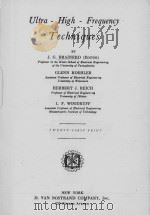
- ULTRA HIGH FREQUENCY TECHNIQUES TWENTY FIRST PRINT
- 1942 D.VAN NOSTRAND COMPANY
-
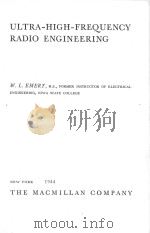
- ULTRA-HIGH-FREQUENCY RADIO ENGINEERING
- 1944 THE MACMILLAN COMPANY
-

- ULTRA-HIGH-PURITY METALS
- 1962 AMERICAN SOCIETY FOR METALS
提示:百度云已更名为百度网盘(百度盘),天翼云盘、微盘下载地址……暂未提供。➥ PDF文字可复制化或转WORD

